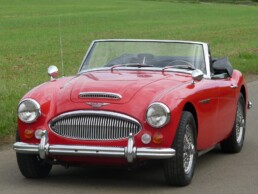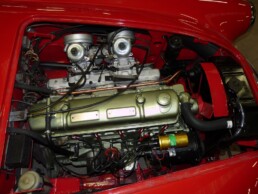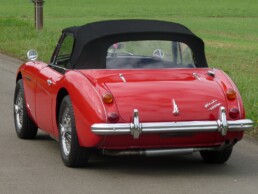History:
The BN4 and BN6, which completed the Austin-Healey 100/6 range at the end of March 1959, were immediately followed by the first 3000 models.
Over the next nine years, 42,922 would follow, the last being delivered to H.A. Saunders, the London BMC distributor.
The 3000 didn’t differ much from its predecessors, but its 2912cc overhead six-cylinder engine now produced 124hp, with compression increased from 8.5:1 to 9:1.
Girling disc brakes were fitted up front and drum brakes at the rear. The 3000 participated in 40 victories in major international rallies with renowned drivers such as Morley Twins, Rauno Aaltonen, Tony Ambrose, Pat Moss, Ann Wisdom and Timo Makinen.
One of these victories was the long Spa-Sofia-Liège rally of 1964.
The developments of the 3000 were conservative: from the MK I BT7 and BN7 from 1959 to 1961 to the MK II from 1961 to 1962 (with three instead of two SU carburettors), and from the MK II BJ7 from 1962 and 1963 to the MK III BJ8 between 1963 and 1968. According to the BMC codification, “N” means two places, “T” means 2 + 2 and “J” convertible. Without overloading the engine, its power was increased to 132 Ch (in 1961), then to 148 Ch in the BJ8.
The British specialist magazine Autocar found, in its road test of August 28, 1959, that the 0-160 km/h acceleration of the 3000 was 32.8 seconds, which was five seconds faster than the 100/6. . And with 185 Km/h, its maximum speed was also 8 Km/h higher. The new car, with its axle ratio of 3.9:1 (4.1:1 on the 100/6), weighs 50 Kg moreover. The engine offers vigorous acceleration and excellent torque.
The BJ8 was available in phase I (1,390 units) and phase II (16,300 units), the differences concern a storage compartment on the rear part of the center console which has been removed and the ground clearance has been increased on the stage II.
It is considered the most comfortable and luxurious. As major changes, note the presence of a precious wood dashboard instead of painted sheet metal, the cabin also has a console and a real glove box. The Mark IIIs were equipped with a dual exhaust system with outlets on the right side.










